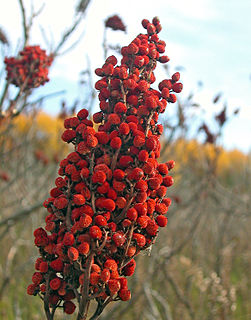
Sumac or, and also spelled sumach, sumak, soumak, and sumaq) is any one of about 35 species of flowering plants in the genus Rhus and related genera, in the family Anacardiaceae. It grows in subtropical and temperate regions throughout the world, especially in East Asia, Africa, and North America.

A near-threatened species is a species which has been categorized as "Near Threatened" (NT) by the International Union for Conservation of Nature as that may be considered threatened with extinction in the near future, although it does not currently qualify for the threatened status.
Myersiohyla is a genus of frogs in the family Hylidae. It was erected in 2005 following a major revision of the Hylidae and initially included four species that were previously placed in the genus Hyla. The genus is found in the tepui region of Guyana and Venezuela.

Lycaste, abbreviated as Lyc in horticultural trade, is a genus of orchids that contains about 30 species with egg-shaped pseudobulbs and thin, plicate (pleated) leaves.
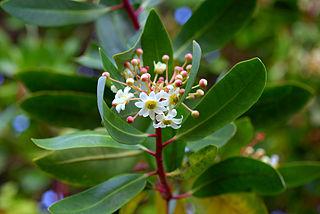
Drimys winteri, the winter's bark or canelo, is a slender tree in the family Winteraceae, growing up to 20 m (66 ft) tall. It is native to the Magellanic and Valdivian temperate rain forests of Chile and Argentina, where it is a dominant tree in the coastal evergreen forests. It is found below 1,200 m (3,937 ft) between latitude 32° south and Cape Horn at latitude 56°. In its southernmost natural range it can tolerate temperatures down to −20 °C (−4 °F).

Pulicaria aromatica is a species of flowering plant in the family Asteraceae. It is found only in Yemen. Its natural habitats are subtropical or tropical dry forests and rocky areas.
Myersiohyla inparquesi is a species of frog in the family Hylidae. It appears to be endemic to the summit of Cerro Marahuaca, a tepui in central Amazonas state, Venezuela. Its natural habitats are tepui shrub and forests. Tadpoles live in fast-flowing streams.
Loveridge's tree frog is a species of frogs in the family Hylidae endemic to Venezuela. Its natural habitats are subtropical or tropical moist lowland forests and rivers.
Antirhea aromatica is a species of plant in the family Rubiaceae.
Bursera aromatica is a species of plant in the Burseraceae family. It is endemic to Jamaica.
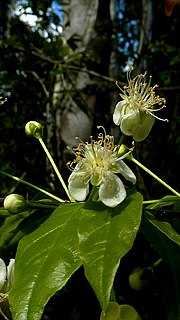
Campomanesia aromatica is a species of plant in the family Myrtaceae. The plant is endemic to the Atlantic Forest ecoregion in southeastern Brazil.
Manglietia aromatica is a species of plant in the family Magnoliaceae. It is found in China and Vietnam. It is threatened by habitat loss.
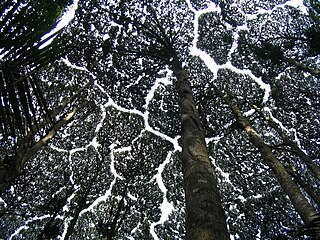
Dryobalanops aromatica, commonly known as Borneo camphor, camphor tree, Malay camphor, or Sumatran camphor, is a species of critically endangered plant in the family Dipterocarpaceae. The species name aromatica is derived from Latin and refers to the smell of the dammar (resin). This species was one of the main sources of camphor and attracted early Arab traders to Borneo, at that time being worth more than gold, and used for incense and perfumes.

Lycaste aromatica, common name the sweet scented lycaste, is a species of flowering plant in the genus Lycaste of the family Orchidaceae.
L. aromatica may refer to:
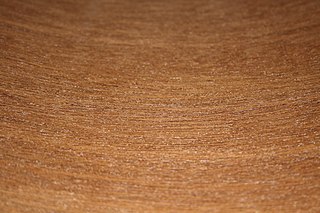
Kapur is a dipterocarp hardwood from trees of the genus Dryobalanops found in lowland tropical rainforests of Malaysia, Indonesia and South-East Asia. It is a durable construction tropical timber. One variety, D. aromatica, is a source of camphor.

Hylinae is a large subfamily of "tree frogs", family Hylidae.
C. aromatica may refer to:
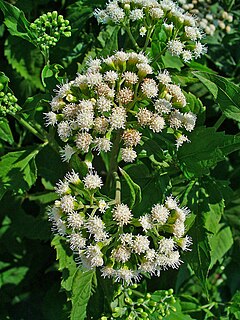
Ageratina aromatica, also known as lesser snakeroot and small-leaved white snakeroot, is a North American species of plants in the sunflower family. It is widespread and common across much of the eastern and southern United States from Louisiana to Massachusetts, as far inland as Kentucky and Ohio.

Josefa Celsa Señaris is a Venezuelan herpetologist. She has published information about frogs and she has identified new genera and species. Señaris is the director of the La Salle Foundation's Natural History Museum in Caracas.












